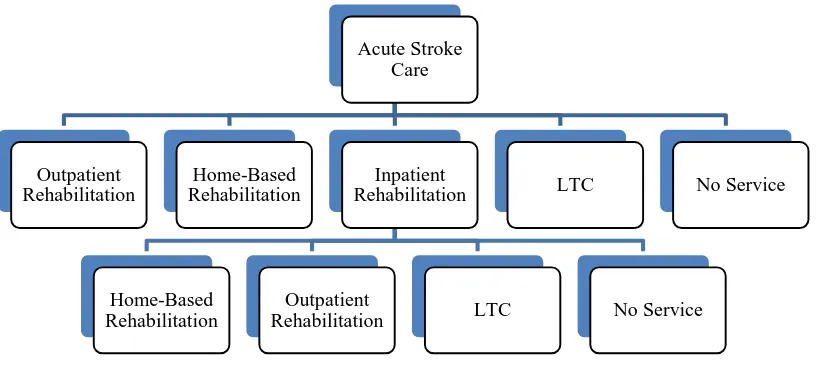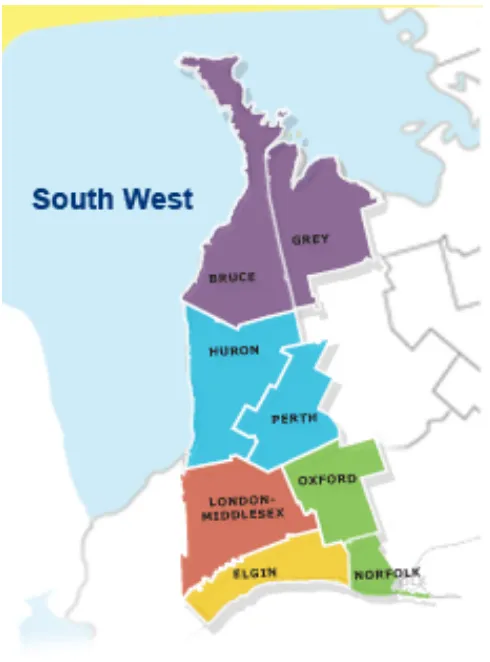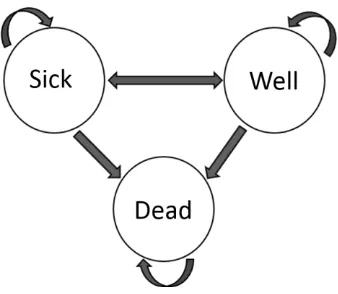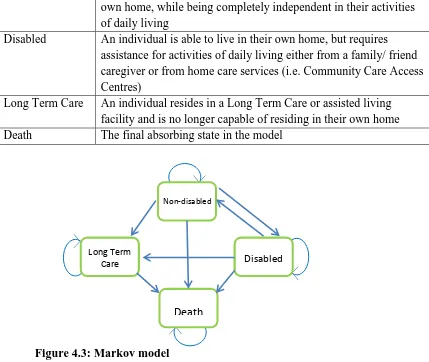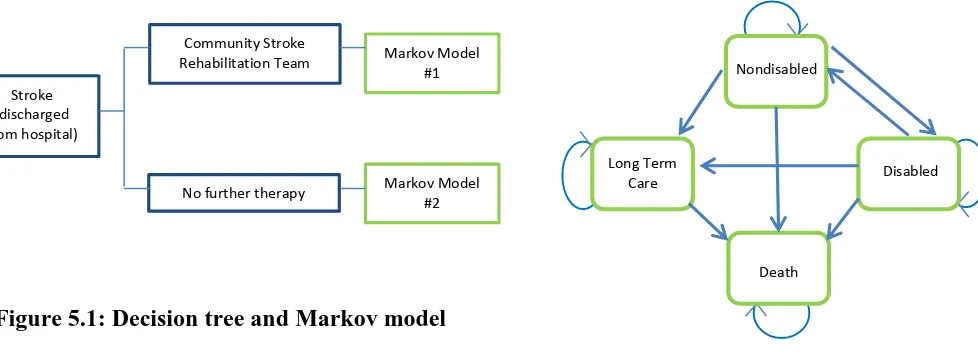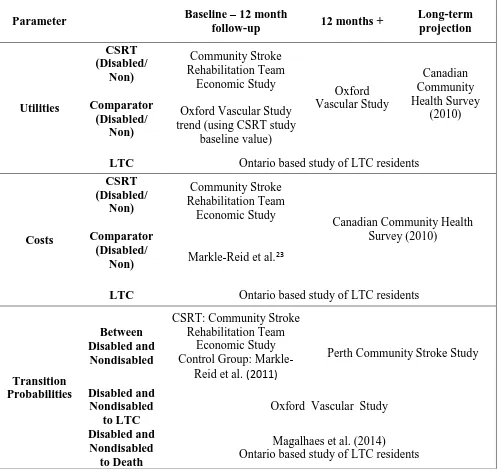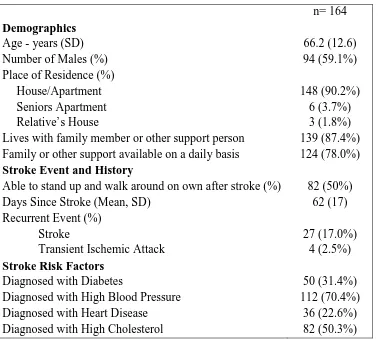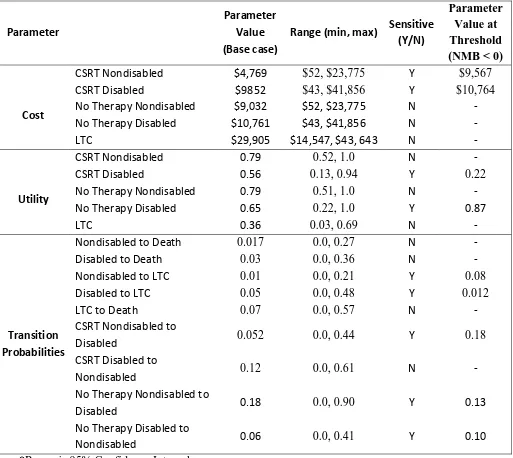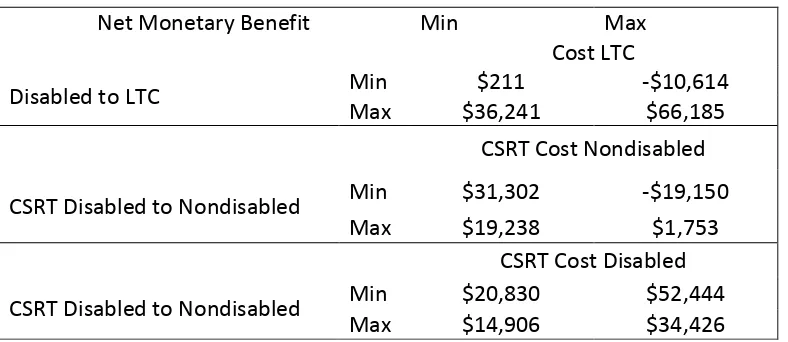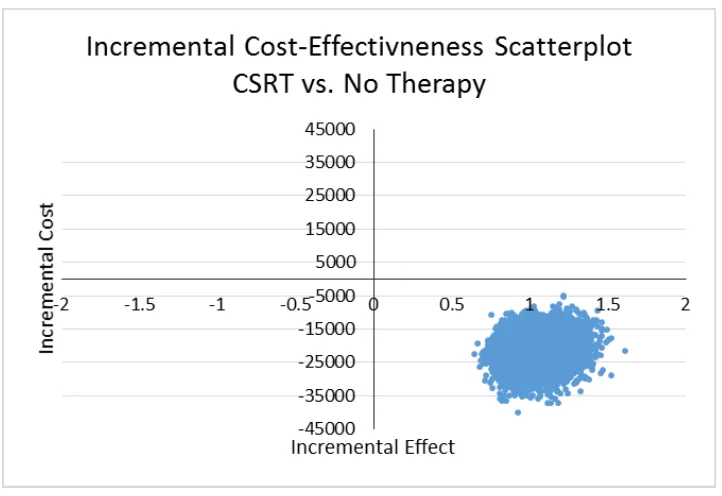Scholarship@Western
Scholarship@Western
Electronic Thesis and Dissertation Repository
5-19-2015 12:00 AM
A Cost-Effectiveness Study of Home-Based Stroke Rehabilitation
A Cost-Effectiveness Study of Home-Based Stroke Rehabilitation
Laura J. Allen
The University of Western Ontario
Supervisor
Dr. Mark Speechley
The University of Western Ontario Joint Supervisor Dr. Robert Teasell
The University of Western Ontario
Graduate Program in Epidemiology and Biostatistics
A thesis submitted in partial fulfillment of the requirements for the degree in Master of Science © Laura J. Allen 2015
Follow this and additional works at: https://ir.lib.uwo.ca/etd
Recommended Citation Recommended Citation
Allen, Laura J., "A Cost-Effectiveness Study of Home-Based Stroke Rehabilitation" (2015). Electronic Thesis and Dissertation Repository. 2900.
https://ir.lib.uwo.ca/etd/2900
This Dissertation/Thesis is brought to you for free and open access by Scholarship@Western. It has been accepted for inclusion in Electronic Thesis and Dissertation Repository by an authorized administrator of
A COST-EFFECTIVENESS STUDY
OF HOME-BASED STROKE REHABILITATION
(Thesis format: Integrated Article)by
Laura Allen
Graduate Program in Epidemiology & Biostatistics
A thesis submitted in partial fulfillment
of the requirements for the degree of
Master of Science, Epidemiology & Biostatistics
The School of Graduate and Postdoctoral Studies
The University of Western Ontario
London, Ontario, Canada
ii
Abstract
Stroke is often a severe and debilitating event that requires ongoing rehabilitation. The
Community Stroke Rehabilitation Teams (CSRT) offer home-based stroke rehabilitation to
individuals for whom further therapy is unavailable or inaccessible. The objective of this
study was to evaluate the cost-effectiveness of the CSRT program compared with a ‘No
Therapy’ cohort. Data were collected on CSRT clients from January 2012 to February 2013.
Comparator data were derived from a study of stroke survivors with limited access to
rehabilitation. Literature derived values were used to inform a long-term projection. Using
Markov modelling, we projected the model for 35 years. One-way, two-way, and
Probabilistic Sensitivity Analyses were performed. Results demonstrate that the CSRT has a
Net Monetary Benefit of $43,115 over No Therapy, and is both less costly and more
effective. The CSRT model of care should be considered when evaluating potential stroke
rehabilitation delivery methods.
Keywords
Stroke, Chronic, Rehabilitation, Community, Economic, Long-term, Markov model
iii
Acknowledgments
I would like to gratefully acknowledge my supervisors Dr. Mark Speechley and Dr. Robert
Teasell for their support and encouragement throughout my Master’s studies and thesis
writing, and especially Dr. Ava John-Baptiste for her patience, dedication, and knowledge. I
would also like to thank the Ontario Stroke Network for providing funding for this study, as
well as Dr. Maureen Markle-Reid for generously providing her data for use in the analysis.
Many thanks to the Community Stroke Rehabilitation Teams for their dedication to their
clients and assistance in participant recruitment, and to Karen Heys and David Ure for their
commitment to the project. I would also like to acknowledge Matthew Meyer and Marina
Richardson for their work with the CSRTs and for their contributions to the study.
This thesis is dedicated to my wonderful husband Jeff for his ongoing support and
encouragement, and to our daughter, Leah, for being both a motivation and a much needed
distraction from my thesis work. Finally, I would like to thank my wonderful parents, Luc
and Denise Tetreault, for their unfailing support throughout my life.
All parts of this thesis were written by Laura Allen, with assistance from Dr. M. Speechley,
Dr. R. Teasell, and Dr. A. John-Baptiste. The analysis was completed under the support and
iv
Table of Contents
Abstract ... ii
Acknowledgments... iii
Table of Contents ... iv
List of Tables ... vii
List of Figures ... viii
List of Appendices ... ix
Preface... x
... 1
1 Introduction ... 1
Stroke ... 1
Stroke Rehabilitation ... 2
1.2.1 Acute Stage ... 2
1.2.2 Post-acute stage ... 3
1.2.3 Chronic stage ... 3
Stroke Care in Ontario, Canada ... 3
1.3.1 The South West Local Health Integrated Network (LHIN) ... 5
The Community Stroke Rehabilitation Teams ... 6
... 9
2 Review of the Literature... 9
Home-Based Stroke Rehabilitation... 9
Current Evidence Supporting Home-Based Rehabilitation ... 11
2.2.1 Evaluated Outcomes for Home-Based Rehabilitation ... 12
2.2.2 General Conclusions on Home-Based Rehabilitation... 18
v
Economic Evaluations of Home-based Rehabilitation ... 21
Gaps in the Current Evidence ... 22
... 24
3 Objectives ... 24
Hypothesis... 24
... 25
4 Methods ... 25
Introduction to Economic Analysis ... 25
4.1.1 Types of Economic Analysis ... 25
4.1.2 Perspective ... 26
4.1.3 Health Utility Measurement and QALYs ... 26
4.1.4 The Value of Economic Modelling... 27
4.1.5 Challenges in Modelling ... 28
4.1.6 Markov Models ... 29
4.1.7 Uncertainty in models ... 30
Detailed Methodology ... 31
4.2.1 Markov Model Development ... 31
4.2.2 Data Sources ... 33
4.2.3 Health State Definitions ... 35
4.2.4 Cost Inputs ... 36
4.2.5 Transition Probabilities ... 39
4.2.6 Utilities ... 40
4.2.7 Cost-Utility Analysis ... 41
4.2.8 Sensitivity Analysis ... 42
vi
... 44
5 Integrated Article ... 44
Introduction ... 44
Methods... 46
Results ... 53
Discussion ... 57
Chapter 6 ... 64
6 Discussion & Conclusions ... 64
7 References ... 73
Appendices ... 82
vii
List of Tables
Table 4.1: Definition of health states in Markov model ... 32
Table 5.1: Parameter data sources by timeframe ... 49
Table 5.2: Baseline characteristics of CSRT participants ... 54
Table 5.3: Results of one-way sensitivity analysis and threshold analysis... 55
viii
List of Figures
Figure 1.1: Possible routes of patient flow through the Ontario stroke system ... 4
Figure 1.2: The South West Local Health Integrated Netork30 ... 6
Figure 4.1: Example of a State Transition Diagram ... 30
Figure 4.2: Decision tree for cost-utility analysis ... 32
Figure 4.3: Markov model ... 32
Figure 5.1: Decision tree and Markov model ... 47
Figure 5.2: Incremental cost-effectiveness scatterplot... 57
ix
List of Appendices
Appendix 1: Participant Flow through CSRT Economic Study ... 82
Appendix 2: Breakdown of Costs for CSRT and No Therapy Cohorts (First two cycles) ... 83
Appendix 3: Parameter values used in Markov model ... 84
Appendix 4: Model parameters – One & two-way sensitivity analysis ... 86
Appendix 5: Parameter distributions in the Probabilistic Sensitivity Analysis ... 87
Appendix 6: EQ-5D-5L ... 88
Appendix 7: Stroke Impact Scale ... 91
Appendix 8: Health and Social Services Utilization Survey ... 101
x
Preface
The following thesis is presented in integrated article format. Although care has been taken
1
Introduction
This chapter will provide a brief introduction to the topic of stroke. It will also provide a
background to the efficacy of post stroke rehabilitation, the structure of stroke care in Ontario,
and an introduction to the Community Stroke Rehabilitation Teams.
Stroke
Stroke, also known as a cerebrovascular accident or ‘brain attack’, occurs when the brain is
deprived of blood supply (ischemic stroke) or when the blood-brain barrier is breached via
vascular rupture (hemorrhagic stroke).1 Stroke is a potentially severe and debilitating event that affects up to 50, 000 Canadians each year.2 With better acute care, the number of individuals surviving a stroke is rising, with nearly 85% surviving their initial stroke, often with resulting
impairments.3 As such, stroke is the second leading cause of long-term disability in North America .2
Stroke effects can range in severity, with resulting impairments varying from minor issues that
may resolve within a short time, to severe and long lasting disabilities. The effects of stroke
include physical disabilities, depression and anxiety, problems with language and
communication, perceptual deficiencies, and declines in cognitive abilities, memory, and
executive functioning.1 Many of these outcomes improve substantially if the affected individual
receives specialized rehabilitation. This rehabilitation may begin in the acute care setting, and
often continues well into the post-acute and chronic phase. Specialized stroke rehabilitation is
often an integral component of stroke recovery, and has been shown to result in improved
long-term outcomes for the stroke survivor. 4
Stroke Rehabilitation
The ultimate goal of stroke rehabilitation is to ensure that stroke survivors are able to reach their
maximum recovery potential from physical, psychosocial and cognitive impairments in order for
them to regain as much of their prior function as possible.5 Rehabilitation often aims to improve function in activities of daily living (ADL), facilitate return to work in younger stroke survivors
and those still employed, and improve physical independence, psychosocial, and cognitive
wellbeing.5 Stroke rehabilitation services often have an additional focus on the improvement of social wellbeing, emphasizing the importance of recreation and social activities in a person’s
overall quality of life.
Both the efficacy and effectiveness of stroke rehabilitation have been examined in hundreds of
studies. The Evidence Based Review of Stroke Rehabilitation (EBRSR)4 cites over 1300
Randomized Controlled Trials (RCT) that evaluated therapies for deficits caused by stroke. Many
of these studies focused on the efficacy of treatments for upper and lower limb physical
rehabilitation, cognitive and language therapies, treatments for perceptual impairments,
dysphagia and nutritional interventions, and the value of treatment strategies aimed at community
reintegration. Thousands more observational studies exist, adding to the overwhelming evidence
in favour of rehabilitation therapies following a stroke. These studies examined the effectiveness
of treatments throughout the stroke recovery process, including during the post-acute and chronic
stage, suggesting that rehabilitation should be an ongoing process.
1.2.1
Acute Stage
Five published meta-analyses support the efficacy of specialized stroke rehabilitation services.
All report a reduction in mortality for individuals treated by specialized stroke rehabilitation
services compared with control groups who typically received traditional care.6-10 Positive effects have been noted for reducing mortality (OR = 0.79, 95% CI 0.73-0.86), poor functional outcomes
(OR = 0.87; 0.80 -0.95),10 combined death or dependency (OR = 0.82; 0.73-0.92),9 and combined death or institutional care (OR = 0.82; 0.73- 0.92).9 One meta-analysis8 also found an increased
odds of a stroke survivor returning to their own home following discharge from a specialized
rehabilitation can have an enormous influence on both the improvement in function and quality
of life for not only the stroke survivor, but for family members and caregivers as well.
1.2.2
Post-acute stage
Other studies have examined the impact of post-acute outpatient stroke rehabilitation. These
studies are often more focused on therapies aimed at improving specific deficits. Although results
have been somewhat conflicting, several studies have demonstrated effects of outpatient
rehabilitation including increased independence in activities of daily living,11-13 improvement in social outcomes,14 lower hospital readmission rates,15 improvement in depression and anxiety symptoms,16,17 fewer medical complications,16 and greater functional improvement17 compared with control groups receiving no further therapy.
1.2.3
Chronic stage
Studies of recovery in the chronic phase of stroke are much fewer than the acute and post-acute
stages. When evaluating outpatient rehabilitation in the chronic stage of stroke recovery (>6
months post stroke), significant improvements were noted in activities of daily living,11,12
mobility,18,19 and functional independence 20 compared with controls. However, in the majority of these studies, gains were no longer statistically significant between treatment and control groups
at long-term follow up assessments (i.e. >6 months post baseline).
Stroke Care in Ontario, Canada
There are several treatment pathways a patient may take following acute stroke care. Figure 1.1
provides a visual representation of conventional patient flow through the stroke treatment system.
The traditional tactic in stroke rehabilitation is immediate stroke treatment in an acute inpatient
setting, often followed by transfer to a specialized inpatient stroke rehabilitation unit for
individuals who would benefit from additional inpatient hospital treatment. From hospital,
individuals are often discharged home when appropriate, or to Long Term Care in the case of
severe impairments and lack of necessary caregiver support. Many individuals discharged home
comprehensive outpatient services are often not available and, when present, tend to be available
only in larger city centres and are, therefore, inaccessible to many. These individuals are often
left with no further rehabilitation services.
Figure 1.1: Possible routes of patient flow through the Ontario stroke system
Stroke rehabilitation services traditionally consist of multidisciplinary teams who provide
comprehensive support to their patients. These teams are often made up of the following
specialized services:
- Physiotherapy: facilitate the improvement of mobility and physical activity21
- Occupational therapy: identification, engagement, and improved function in activities
of daily living22
- Speech-language therapy: the treatment of language, speech, voice and
communication disorders23
- Therapeutic Recreational therapy: the incorporation of recreation and leisure as
essential components to improved quality of life24
- Registered Nurse: provision of basic medical support and health education
Although these rehabilitation services are currently available to most individuals at the inpatient
level, and many stroke survivors go on to attend outpatient rehabilitation clinics, there are many
Acute Stroke Care
Outpatient Rehabilitation
Home-Based Rehabilitation
Inpatient Rehabilitation
Home-Based Rehabilitation
Outpatient
Rehabilitation LTC No Service
who have no services available to them or are unable to access these services. In-home,
community-based rehabilitation aims to fill this extensive and concerning gap.
Current Canadian stroke rehabilitation guidelines exist to ensure that stroke survivors receive the
best evidence based stroke rehabilitation care possible. The Canadian Best Practice
Recommendations for Stroke Care are widely practiced and encompass guidelines specific to
acute, inpatient, outpatient, and community-based rehabilitation.25 The guidelines are updated periodically with recommendations supported by the literature and past studies of high
methodological quality. They embrace rehabilitation as a multidimensional approach,
incorporating medical, social, emotional, and vocational resources to optimize recovery.26 It has been postulated that consistent access to this organized, multifaceted approach to stroke
rehabilitation could save the Canadian health care system $8 billion over the next 20 years
through both stroke prevention and reduction in disability.27
The Canadian Best Practice Guidelines for Stroke Care (2013), Outpatient and
Community-Based Rehabilitation, state that individuals with ongoing needs “should continue to have access
to specialized stroke services after leaving hospital” and that “[o]utpatient and/or
community-based rehabilitation services should be available and provided by a specialized interprofessional
team, when needed by patients […]”.25 The guidelines further state that this rehabilitation should
be provided in the most appropriate setting, including the person’s own home.28
1.3.1
The South West Local Health Integrated Network (LHIN)
The South West LHIN, located in the province of Ontario, Canada, covers a large geographic
area of approximately 21,639 square kilometers and encompasses Middlesex, Oxford, Eglin,
Huron, Perth, Grey, Bruce, and a portion of Norfolk counties (Figure 1.2). It is home to nearly 1
million residents, including a large rural population. Over 23% of individuals living in this LHIN
who experienced a stroke in 2013 are considered to be rural residents.29
Stroke services in the South West LHIN are currently centered in 2 dedicated acute stroke
hospitals. Hospital-based outpatient rehabilitation services are currently available at 14 sites.
Despite this, over 35% of stroke patients, including 40% of acute patients, are discharged home
remaining requiring ongoing rehabilitation.2 Furthermore, 25% of stroke sufferers are left with
minor disability, and 40% with major disability, requiring therapy.2 This demonstrates a large
service gap in access to rehabilitation services in individuals who would benefit from further
rehab.29
Figure 1.2: The South West Local Health Integrated Netork31
The Community Stroke Rehabilitation Teams
The Community Stroke Rehabilitation Teams (CSRT) were founded in 2009 and service the
eight counties of the South West LHIN. These teams receive annual funding provided by the
South West LHIN. They aim to provide Canadian Best Practice Recommendations for Stroke
access traditional outpatient rehabilitation services due to mobility, transportation, or
geographical limitations.
Due to the large geographic area of the Southwest LHIN, the CSRT program comprises three
individual teams centred in three cities across the LHIN. The Thames Valley team is located in
London and serves Middlesex, Elgin, Norfolk, and Oxford counties; the Huron Perth team is
located in Seaforth and provides therapy to clients in Huron and Perth counties, and the third
team is centred in Owen Sound and serves Grey and Bruce counties.
The CSRTs deliver an interdisciplinary approach to stroke rehabilitation by providing service
individualized to each client. This may involve physical rehabilitation, social and emotional
support, education, system navigation, and caregiver support.32 Provision of these services may involve the support of a registered nurse, social worker, occupational therapist, physiotherapist,
speech-language pathologist, therapeutic recreation therapist, or rehabilitation therapist. These
therapists work together to provide a comprehensive program of rehabilitation to each individual,
and provide this therapy directly in a person’s home and around their community. It has been
suggested that comprehensive and intensive rehabilitation is more effective than less intense
programs of therapy.5The CSRTs are able to provide relatively intense rehabilitation, with type and frequency of visits individualized to each client, in a home setting.
Although there is currently a lack of published data on the cost of this particular program relative
to hospital-based outpatient services, or no rehabilitation service, anecdotal evidence from the
CSRTs indicates that clients served by the CSRTs may access fewer health care resources over
time. These include readmission to hospital, emergency room visits, general physician visits, and
other social services. There may also be decreased costs to the patient as a result of fewer travel
costs, private therapies accessed, and loss of employment wages, particularly accrued by family
members who often must provide transportation to the outpatient facility. It is hypothesized that
the upfront cost of the CSRTs to the health care system is greatly offset over time by cost savings
in these other areas.
Based on the lack of published evidence pertaining to the economic value of the CSRTs, the
provide an evaluation of the existing literature on specialized stroke rehabilitation, in particular
2
Review of the Literature
Home-based stroke rehabilitation programs have been the subject of a number of studies around
the world. This chapter provides a review of the evidence pertaining to the effectiveness of
home-based rehabilitation. For the purposes of this review, studies of Early Supported Discharge
(ESD) programs have generally not been included as ESD is not the mandate of the Community
Stroke Rehabilitation Teams. Clients served by the CSRTs come from a range of referral sources,
while Early Supported Discharge programs often act exclusively as a substitute for inpatient
rehabilitation, treating patients in the acute phase of their stroke. The economic burden of stroke
in Canada, and current evidence surrounding the cost-effectiveness of home-based rehabilitation,
also will be reviewed.
Home-Based Stroke Rehabilitation
In the majority of health care systems, stroke care is initially offered in the inpatient hospital
setting. Many individuals, upon discharge, are able to receive ongoing rehabilitation in the
hospital-based outpatient setting. However, these outpatient services are not available to all
stroke survivors with ongoing needs.
In recent years, the idea of home-basedrehabilitation has begun to garner support as a practical
option for delivery of specialized stroke therapy services following discharge from hospital. This
type of service is often directed at individuals who have ongoing rehabilitation needs and for
whom traditional hospital-based outpatient rehabilitation services are not available, not accessible
(i.e. transportation barriers), or simply as an alternative to traditional facility-based outpatient
services.
Home-based stroke rehabilitation teams, as the name suggests, provide services directly in a
person’s home and, in some cases, in their community. These teams most often limit their therapy setting to a person’s household environment, however, some of these teams may also offer
grocery store with their therapist, practicing communication skills in the local coffee shop, or
climbing and descending the stairs of the local post office.
These home-based programs often structure their highly individualized therapies around a
person’s specific goals, and focus on improving activities of daily living to optimize function.
This approach may be quite effective as a person’s home is often the most appropriate and
effective setting for this recovery to take place. In this way, stroke patients are better able to cope
with, and overcome, barriers specific to their home and community environments. This
client-centred approach to stroke rehabilitation can be effective and is often valued highly by the stroke
survivor.
Home-based stroke rehabilitation programs differ greatly in their professional make up, client
inclusion criteria, and organization of services. They may also vary in the intensity of therapies
and length of services offered.
Although it is well recognized that home-based stroke teams vary widely in professional makeup,
studies examining the effectiveness of these teams do not often describe this in great detail. These
teams most often consist of some combination of team coordinator, physiotherapist, occupational
therapist, speech-language pathologist, social worker, nurse, and recreational therapist. In the
majority of cases, however, teams consist of a physiotherapist and occupational therapist as their
core component. In a systematic review by Winkel et al.,33 all eight of the included studies involved these two disciplines as a part of their multidisciplinary team structure.33 Five of the examined studies also included a registered nurse as a part of their offered services, and a
speech-language therapist was included in four teams. In two studies, social workers were permanent
members of the rehabilitation team, but were included only on a consultation basis in several
other programs. A number of studies also included the direct involvement of a physician. Upon
further examination of the literature on in-home stroke rehabilitation teams, additional health care
professionals such as psychologists,34 dieticians,34 therapy aides , and physical medicine
physicians34 also have been included as members of these interdisciplinary teams. Additionally, some in-home rehabilitation teams are offered in combination with personal support worker and
The majority of home-based stroke rehabilitation programs described in the literature have wide
eligibility criteria. Most programs offer therapy to any adult stroke survivor who has
rehabilitation needs as a result of their stroke and is able to participate in therapy.26,34-38 Other programs limit services to only those with acute stroke.39,40 Some home-based stroke programs
may offer services in the form of Early Supported Discharge (ESD) from hospital, which allows
patients to return to their own homes with support days and even weeks sooner than may
otherwise would have occurred in the absences of such a program. 33,40-42
The intensity of therapy provided to clients served by home-based stroke rehabilitation teams
may also varies widely. In many cases, the amount and duration of therapy provided is highly
individualized to each client.26,37,40-42 Other structures consist of a predetermined maximum of anywhere from two38 to five34 sessions per week, and include a maximum duration of services. Programs may also incorporate a period of self-management in which stroke survivors are able to
practice the skills they have acquired during the period of rehabilitation.38
Current Evidence Supporting Home-Based Rehabilitation
Although in-home rehabilitation provides a unique opportunity for recovery in the most useful
and practical environment, evidence of the effectiveness of home-based stroke rehabilitation
programs is still incomplete. Many of the currently available Randomized Controlled Trials and
observational studies compare this type of care to hospital-based outpatient rehabilitation, with
the majority of studies conducted in the United Kingdom, Australia, and Scandinavia.
Furthermore, the majority of this literature compares this type of program with an Early
Supported Discharge (ESD) approach to inpatient rehabilitation. Both inpatient rehabilitation and
traditional outpatient services are efficacious in improving patient outcomes post stroke.4 Many of the studies comparing home-based vs. hospital-based rehabilitation test the null
hypothesis that one treatment approach is ‘non inferior’ to the other. In other words, they aim to
demonstrate that home-based rehabilitation is as effective as traditional outpatient-based services.
It has been widely demonstrated that outpatient therapies are effective at improving a wide range
important to consider, should be interpreted with caution as clinically meaningful differences
specific to each outcome measured may differ from statistical significance. Likewise, clinically
meaningful changes may be observed in one treatment group and not another without being
statistically different.43
2.2.1
Evaluated Outcomes for Home-Based Rehabilitation
2.2.1.1
Functional OutcomesThe majority of studies of the efficacy of in-home rehabilitation post stroke have looked at areas
of disability, physical function, and improvement in activities of daily living (ADL) as primary
outcomes. ADLs include basic activities such as grooming, toileting, and other forms of
self-care, household and other day-to-day tasks, as well as leisure activities. These outcomes are
important measures of the disability level of an individual.
A number of outcome measures are used to quantify disability following a stroke. The most
commonly used internationally are the Barthel Index (BI), the modified Rankin Scale (mRS), and
the Functional Independence Measure (FIM), although many more exist.44 These measures have been the subjects of numerous validation studies, and cut-off scores for various disability levels
are well established.45-49 Increasingly, the Stroke Impact Scale (SIS)50 is being used as a measure
of function following stroke, particularly in North America. The short form of this measure, the
SIS-16, is used to create a physical dimension score. This measure has been validated in
comparison to both the mRS and the Barthel Index and has been shown to be able to distinguish
among disability levels of both measures.51,52 A person’s level of disability in the months
following stroke has been shown to have an impact on their continued recovery, independence in
daily activities, and overall health related quality of life.53-56
Disability and Activities of Daily Living
Significant improvements in ADLs in home-based intervention groups have been observed in the
majority of studies examining this outcome; however, in most cases the intervention group was
compared with a control group receiving outpatient rehabilitation and researchers were not able
to observe differences between the two cohorts.34-37,39,40,57 In one study, although there were no significant differences between study groups, an earlier improvement was noted in the home
favour of home-based treatment groups when compared with hospital-based controls. Studies by
both Gladman et al.59 and Chaiyawat and Kulkantrakorn17 showed greater improvement in
independence in activities of daily living (Barthel Index, p<0.05 at six month follow up; Barthel
Index, p=0.03 at two years).17,59 In a one group, pre-post study design by Sirbu et al.,38 study
investigators were also able to observe significant improvement in activities of daily living
(Barthel Index, p=0.02).38 There is a consensus that in-home rehabilitation is successful in increasing independence in activities of daily living.
Motor Skills
Improvement in motor function is also commonly assessed in the context of in-home
rehabilitation. As is the case with improvements in ADLs, in-home rehabilitation programs are
able to demonstrate significant improvements over time. However, when between group
comparisons are examined, no superiority of home-based rehabilitation was observed over
hospital-based therapy. This was the case in studies of manual dexterity,39,40 assessments of motor processing skill,34 motor impairment as measured by the Motricity Index and the Motor Assessment Scale,35,39 and upper extremity motor control and dexterity on the Frenchay Arm Test.39 Bjorkdahl et al.58 were also not able to observe a between-group difference in motor function improvement, although an earlier improvement was noted in the in-home rehabilitation
intervention group.58 Conversely, in a one group pre-post-test, Sirbu38 was not able to observe any significant improvement in motor functioning on the Motricity Index between time points.38 Once again, motor function appears to improve in individuals receiving in-home therapy services
post stroke.
Mobility
Along with motor function and independence in ADLs, mobility is typically assessed as a
measure of overall physical functioning in the stroke patient. Once again, home-based therapy
has repeatedly been demonstrated to show significant improvements in mobility, although it has
not been shown to be superior to control participants receiving hospital-based services in
group pretest-post-test design demonstrated a significant improvement in mobility on the Berg
Balance Scale (p=0.05).38
Overall Functional Recovery
Overall function is also often assessed when examining the effectiveness of in-home
rehabilitation. Although significant improvements are typically observed in overall health, daily
activities, mobility, and social functioning, they have not been observed to be superior to
improvements seen in individuals accessing traditional outpatient or community services. This
has been observed in results from the Functional Independence Measure,57 Nottingham Health Profile,59 and National Institute of Health Stroke Scale.58 Furthermore, when compared with individuals receiving limited community rehabilitation services, a recent Canadian study by
Markle-Reid et al.26 was not able to observe any superiority of the home-based intervention program on this particular outcome. Additionally, two studies have shown dominance of
hospital-based rehabilitation on improvements in overall measures of function as was observed in a study
of young stroke survivors by Bjorkdahl et al.58 Superiority of hospital over home-based
rehabilitation in functional improvement was also observed by Crotty et al.,34 although authors acknowledge a substantial risk of bias with this result.34
Finally, authors of two studies have compared in-home rehabilitation treatment groups with
controls in the area of overall activity level. Ljungberg et al.57 observed significant improvements in activity level, information level, and participation in the planning of program activities (all
p<0.05) in home-based treatment groups.57 Conversely, Anderson et al.42 were not able to
observe such an effect when examining the impact of in-home rehabilitation on activity level in
the context of early supported discharge.42
Overall, in-home rehabilitation has been widely demonstrated to be effective at improving
physical outcomes of stroke patients including improving independence in activities of daily
living, motor function, and mobility. There is conflicting evidence that home-based rehabilitation
is able to improve an individual’s overall function when compared with a hospital-based
2.2.1.2
Psychosocial Well-beingThe psychosocial wellbeing of stroke survivors is also often examined in studies assessing
in-home rehabilitation programs. These studies typically look at the presence and severity of anxiety
and depressive symptoms, but may also examine patient satisfaction, coping skills, and return to
normal social functioning. In the majority of studies, as with physical and functional outcomes,
improvement in the psychosocial domain was not found to have improved to a greater degree in a
sample receiving in-home rehabilitation when compared with outpatient therapy services.
However, in most cases, statistically significant improvements were observed in both groups on
measures such as the Hospital Anxiety and Depression Scale,35,36,39 and the Geriatric Depression Scale.34 One study looking at in-home rehabilitation compared with a control group receiving limited services was not able to detect any difference in depression and anxiety symptoms.26 Conversely, Chaiyawat and Kulkantrakorn17 was the only study to detect a significant
improvement in a treatment group compared with a control group who had limited access to
post-stroke rehabilitation services (p<0.01).17 This suggests that home-based therapy is not inferior to hospital-based treatment in improving symptoms of depression and anxiety in stroke survivors,
and may be superior to a no therapy alternative.
An improvement in coping skills was examined in one study40 in the context of Early Supported Discharge and was found not to be significantly better in the treatment group versus controls
discharged early from inpatient rehabilitation. Reintegration to normal living was also examined
by one group. There were no significant improvement in treatment subjects compared with
controls who did not receive rehabilitation.26
In an RCT by Lincoln et al.,37 participants receiving services from a community stroke
rehabilitation program were significantly more satisfied with the emotional support they received
from the team compared with controls receiving services outside the home setting as measured by
a study assessment measuring emotional satisfaction with services (p=0.02). Similar results have
2.2.1.3
Caregiver BurdenMany home-based rehabilitation programs also provide support to family members and friends of
stroke survivors, aiming to improve caregiver outcomes following stroke. These most often focus
on psychosocial wellbeing, as well as overall health status.
In an RCT by Lincoln et al.,37 caregivers of persons who suffered a stroke who received services
from home-based rehabilitation programs reported considerably less burden (p<0.04), and
reported more knowledge of stroke (p=0.03) than the hospital outpatient-based control group.
Furthermore, these caregivers showed greater improvement on the Caregiver Strain Index
(p=0.03) and reported a greater overall satisfaction with services (p=0.01). Although Lincoln et
al.37 were able to demonstrate less caregiver strain in treatment groups at a six month follow up, a study by Crotty et al.34 did not show a similar effect. However, a significant result was observed in this study upon hospital discharge (p=0.047). Several other investigators have not been able to
show any improvement in treatment groups over controls when examining caregiver
outcomes.34,35,37,39,42
Converse to outcomes of physical and psychosocial recovery in stroke patients, studies that
examine improvements in caregiver outcomes have been able to show more benefit in favour of
home-based treatment groups when compared with standard rehabilitation controls.
2.2.1.4
General Morbidity and MortalityA number of common outcome measures exist that assess overall general physical and cognitive
wellbeing. Furthermore, general health outcomes may also be used to assess overall health status.
As previously observed with other outcome domains, significant improvements in overall health
status are generally are not observed when comparing home-based rehabilitation services with
standard outpatient care or early supported discharge. However, in the majority of cases both
intervention and control groups show significant improvement over time on measures such as the
General Health Questionnaire,37 EuroQol,36,37 and the Short Form Health Survey (SF-36).34,42
Markle-Reid et al.,26 whose study compared in-home rehabilitation with limited post stroke
therapy services, was able to demonstrated an improvement in the treatment group on five out of
eight subscales on the SF-36.26 Although none of these comparisons reached statistical
Improvements in cognitive functioning are also often assessed. As before, very few studies have
demonstrated any superiority of home-based rehabilitation when compared with traditional
rehabilitation services, although statistically significant improvements in these outcomes are
observed in both groups, particularly on the Mini Mental State Examination.34,35,40,42 One study
was not able to find superiority of at home rehabilitation in improving cognitive outcomes when
compared to a no or limited therapy group.17 Furthermore, one study found no improvement in cognition in either the intervention or the control group on the Barrow Neurological Institute
Screen for Higher Cerebral Functions.58 Conversely, a Randomized Controlled Trial by Ljungberg et al.57 did show significant improvement in several cognitive domains when
compared to a control group. Between admission and study end, significant improvements were
observed in expression (p<0.01) and problem solving (p<0.05). Furthermore, between admission
and 4 week follow up, significant improvements were seen in comprehension (p<0.05), problem
solving (p<0.01), and memory (p<0.05) domains on tests of neurological status and cognitive
functioning.57
Rates of death, institutionalization, hospital readmissions, and recurrent stroke have also been
reported by few studies. One study comparing home and hospital rehabilitation did not detect any
significant difference between the two groups on death rates and rates of institutionalization.59 Furthermore, when compared with no or limited therapy, investigators did not detect any
significant difference in the rates of recurrent strokes or hospital readmissions in their study
participants.26
2.2.1.5
Other BenefitsA number of additional benefits of community and in-home stroke rehabilitation have been cited
throughout the literature. These include, but are not limited to, providing a means of early
supported discharge from inpatient hospital care, and greater patient and caregiver satisfaction
with the program.
The potential for Early Supported Discharge (ESD), although not discussed in this review, may
also lead to cost savings through shorter hospital stays, as well as an early return to independence
length of hospital stay in individuals discharged to in-home rehabilitation (Holmqvist et al.: 14
vs. 29 days, p=0.0008).40,42
It has also been reported that home-based rehabilitation can result in increased satisfaction in
services for both patients and caregivers. A study conducted in Sweden by Von Koch,
Wohlin-Wotricht, and Widen-Holmqvist41 found that home-based therapy enabled patients and family to be involved in the planning process, and allowed for greater opportunity to set relevant and
achievable rehabilitation goals through a greater understanding of the needs and context of the
programs clients. This resulted in greater client and caregiver satisfaction. Ljungberg et al.57 cited that further benefits include a person’s opportunity to make their own choices, which may further
lead to the potential to be more active and motivated.57
2.2.1.6
Meta-AnalysisMeta-analysis of outcomes related to in-home rehabilitation is a challenge due to heterogeneity
between programs, therapy intensities, structures, services provided, and outcomes examined. In
a meta-analysis of Randomized Controlled Trials comparing home-based and centre-based stroke
rehabilitation facilities, home-based services were associated with greater client satisfaction,
reduced caregiver strain, lower readmission rates, and increased function and ADLs in a broad
summary of results.33Pooled analysis of functional outcome as measured by the Barthel Index also demonstrated a significant increase in functional independence compared with control
groups by 6-8 weeks post intervention (p=0.03). Analysis of six month follow up scores also
revealed significant improvements compared with controls on this measure (p=0.04). This
review noted that home-based rehabilitation may be superior from a patient outcome perspective,
in part because individuals have the opportunity to immediately transfer skills they have learned
in their own living environment.62
2.2.2
General Conclusions on Home-Based Rehabilitation
A number of published studies have examined patient outcomes following home-based stroke
rehabilitation. Although these studies vary in program structure, process, and outcomes assessed,
they generally concur on the ability of home-based, specialized, interdisciplinary, stroke
rehabilitation services to produce significantly positive outcomes in stroke patients similar to
studies did not demonstrate superior improvements when compared to traditional services, the
preponderance of analyses demonstrated significant improvements in level of disability,
psychosocial well-being, caregiver outcomes, general health and well-being, and a variety of
other positive benefits in study groups who received home-based rehabilitation compared to
baseline. This supports the evidence base for the efficacy of home-based stroke rehabilitation.
However, evaluations of ongoing programs are warranted to further validate the efficacy of this
treatment approach.
The Cost of Stroke in Canada
The costs of stroke to the Canadian economy are enormous. An estimated $3.6 billion is incurred
each year due to both the direct and indirect costs of stroke.63 Although the majority of costs are related to acute and inpatient care, a substantial amount is attributed to post-acute rehabilitation,
stroke prevention, and physician visits for both primary stroke follow up and attributed medical
comorbidities such as depression, urinary tract infections, and pain.64 A recent systematic review
found an estimated 30.0-62.2% of individuals will be readmitted to hospital following post-acute
care for all cause morbidity, and an additional 20% of stroke survivors will experience a recurrent
stroke,1 resulting in considerable added cost to the health care system. An estimated 80% of costs during the first six months following stroke are direct costs to the health system.63
A recent Canadian study, The Economic BURden of Ischemic STroke Study (BURST),65 examined
the cost of ischemic stroke in Canada over a one year period. This study demonstrated that the
average per person cost of a stroke in Canada over a one year period is approximately $75,000,
with disabling stroke being almost twice the cost of nondisabling strokes. Furthermore, during
the acute phase of recovery, nearly half (46.8%) of these costs are attributed to hospital admission
with rehabilitation costs constituting a large portion (34%). Post discharge from hospital, indirect
costs, such as lost productivity and out of pocket expenses, become the highest contributor
(58.3% at 4-6 months, and 42.3% at 7-12 months post stroke). This high cost of stroke is an
enormous burden to both the health care system and the stroke survivor during this one year
Recently, it has been postulated that optimization of stroke care systems in Canada throughout
the stroke care continuum could dramatically impact stroke costs related to stroke, reducing the
yearly economic burden of stroke by as much as $682 million annually, including $307.4 million
in direct and $374.3 million in indirect costs.66 This may be accomplished through the
implementation of evidence based stroke care in the acute phase, through organized stroke units,
and through home supported discharge. Furthermore, the estimated 286 000 Quality Adjusted
Life Years (QALY) lost annually to stroke could be decreased by as much 10 568 QALYs.66 Post stroke disability level also has a considerable impact on post stroke costs. This has been
demonstrated by the BURST study65 in a Canadian context as discussed above. Dawson et al.67 also demonstrated an incremental increase in health care utilization costs with increased disability
level as measured by the modified Rankin Scale. This impact of disability level on stroke costs
has been demonstrated in a number of international studies, and is largely due to the increased
use of care services, institutionalization, and hospital admissions by individuals experiencing
more disability.68-71
In addition to costs to the health care system, stroke patients and their families experience a
negative economic impact. This may largely be due to loss of productivity in the form of lost
wages for both the stroke survivors and their caregivers, at least during the period of acute
recovery, and an estimated 27-81% of individuals are unable to return to work at all.72 Travel costs for doctor visits and outpatient rehabilitation may also accumulate to a large degree.
Furthermore, stroke patients may seek the services of private therapists, accruing personal costs
for these services. The majority of these indirect costs are incurred during the post-acute phase,
following discharge from inpatient stroke care.63
Post-acute rehabilitation is vital to reduce the adverse effects of the stroke, improve quality of
life, decrease the need for activity of daily living supports, support return to work, reduce the
severity and number of stroke co-morbidities, and decrease the risk of recurrent stroke.5 In effect, the reduction of these adverse consequences of stroke will help alleviate some of the burden of
Economic Evaluations of Home-based Rehabilitation
Few economic reviews have examined the costs of home-based programs in the post-acute stage.
The majority of these studies examined the costs of these programs in the context of an early
supported discharge program. Far fewer looked at cost differences in comparison to
hospital-based outpatient programs.
Most studies have found that home-based services are no more costly than outpatient
hospital-based programs, and in some cases are more cost-effective. Roderick et al.73 looked at both health and social service costs accrued by participants during the study period and found that
there were no statistically significant differences between those accessing in-home rehabilitation
and individuals in an outpatient program. While similar overall health service costs were
observed in the two groups, slightly higher social service costs were noted in the home-based
group. Similar cost outcomes were also noted by Gladman et al.,74 with slightly lower health service costs observed in the hospital-based cohort. Bjorkdahl et al.58 also examined the costs of
home-based rehabilitation as an alternative to an outpatient hospital program. This study solely
examined the costs of the two programs themselves, and did not include any additional health
care costs. The authors found that the program cost of home rehabilitation was less than half
(42%) of hospital based rehabilitation. Anderson et al.42 conducted a systematic review of the economic impact of home-based rehabilitation programs, including those with an early supported
discharge component, and found that, overall, home-based rehabilitation reduced hospital stays
by 13 days (95% CI: -19 to -7 days). Furthermore, overall mean costs for community stroke
rehabilitation care in combination with early discharge from hospital resulted in an overall mean
cost reduction of 15% without compromising patient outcomes.42
Recently, a Randomized Controlled Trial26 was conducted in Ontario, Canada examining home-based stroke rehabilitation provided by the Community Care Access Centre (CCAC), an agency
that coordinates home care services for individuals with activity of daily living difficulties.75 This program has sometimes been called ‘Enhanced CCAC’ and offers an interdisciplinary approach
to in-home stroke rehabilitation. In this study, individuals were randomized to receive either the
Enhanced or the traditional level of CCAC services, with minimal access to additional stroke
services. Authors aimed to answer the question of whether this 12 month specialized stroke
Assessments were completed at baseline and 12 month follow-up. Cost analysis of the program
revealed a slightly although not significantly higher per person cost in the use of health services
for the intervention group as measured by the Health and Social Services Utilization Survey. It
was concluded that this program is a feasible approach to traditional outpatient services. It was
noted, however, that a small sample size (N=101), may have resulted in an unrepresentative
sample. Furthermore, a greater length of follow-up time may be important to detect differences in
the cost of health resource utilization over the long-term. This Ontario based study is an excellent
example of the cost-effectiveness of home-based stroke rehabilitation in the Canadian context.26 In general, there is substantial heterogeneity of results when examining the effectiveness of
home-based stroke rehabilitation programs in terms of patient outcomes in relation to cost
savings.76 This is likely due to the fact that the majority of studies examining home-based rehabilitation for stroke patients differ on aspects of the programs themselves, structure of the
interdisciplinary teams, as well as the differences in health care system structures between
countries around the world. Furthermore, studies generally have small sample sizes and limited
follow up. This may also have implications for extrapolating the effectiveness of results and the
cost implications to the Canadian context.
Gaps in the Current Evidence
Although there are a number of studies that support the effectiveness of home-based
rehabilitation programs, few were able to demonstrate a great deal of added benefit when
compared with traditional hospital-based rehabilitation services. This suggests that in-home
rehabilitation is comparable to outpatient rehabilitation in its effectiveness; however, it does not
provide a definitive indication of whether this approach is superior to no therapy. Given that
home-based rehabilitation has been found to be likely non-inferior to hospital-based outpatient
services, and hospital-based programs have been demonstrated to be effective at improving
patient outcomes, it can be inferred that home-based programs are of benefit. For the large
number of individuals who are discharged from inpatient stroke care with no further services,
access to a home-based program may be of particular value and should be the subject of further
This same problem is encountered when considering economic evaluations of such programs. No
studies have been published evaluating the cost-effectiveness of a home-based stroke
rehabilitation program in comparison to a cohort of individuals who are not able to access any
further rehabilitation services. This is an important consideration as it is imperative from a policy
and funding standpoint that such a program is, in fact, worth the resource contribution.
Furthermore, no studies have been conducted examining the projection of long-term costs and
benefits of such a program in any context.
Studies in the current literature are also difficult to compare. Interdisciplinary team structures,
length and intensity of services, and approaches implemented vary widely. Furthermore,
characteristics of comparison groups in Randomized Controlled Trials vary just as widely, adding
an additional challenge. Cost analyses that have been completed are also very heterogeneous,
varying drastically across geographic and health care settings, and are often based on small
sample sizes and diverse stroke populations. This makes it very difficult to extrapolate results of
these studies to existing programs. This emphasizes the importance of evaluations of individual
programs in terms of both program costs and outcomes, to assess the overall efficacy and
3
Objectives
The Community Stroke Rehabilitation Teams represent a unique model of care. Rehabilitation
programs similar to the CSRT have yet to be fully evaluated in an economic context. In
particular, comparisons to a cohort receiving No Therapy are limited. Comparison to a No
Therapy population is relevant in the CSRT context as, for the majority of CSRT clients,
alternate rehabilitation services are not available. Additionally, there are no long-term projections
of cost-effectiveness of a home-based stroke rehabilitation program in any context.
As such, the objectives of this analysis are:
1. To determine the long-term costs and consequences of a home-based stroke rehabilitation
program, Ontario’s Community Stroke Rehabilitation Teams.
2. To determine the long-term cost-effectiveness of the Community Stroke Rehabilitation
Teams compared to a cohort receiving no further rehabilitation therapy.
Hypothesis
We hypothesize that a long-term projection of the costs and consequences of the CSRT model of
4
Methods
The purpose of this chapter is to provide a brief background to the terms used and the rationale
underlying economic evaluations of health care programs, devices, drugs and other interventions.
This chapter will also provide a detailed methodology of the approaches taken to develop the
economic model used in this analysis
Introduction to Economic Analysis
Economic evaluations are an important aspect of most decisions in health care. Drummond et al.
define economic evaluation as “the comparative analysis of alternate courses of action in terms of
both their costs and consequences.”77(p.9) Modelling in economic evaluations is valuable to inform decision making processes, guide clinical practice, and optimize the use of health care
resources.78
4.1.1
Types of Economic Analysis
There are four main types of economic evaluations: minimization, benefit,
cost-effectiveness, and cost-utility. While all four approaches can aid decision making and be
invaluable to policy makers and decision support personnel, they differ in terms of their
applications.
Cost-minimization analyses simply look at the costs of a program, irrespective of any benefit or
outcome it may produce. In cost-minimization analyses the underlying assumption is that there is
no difference in health outcomes between the two comparators and thus only the cost difference
is relevant. Cost-effectiveness analysis and cost-utility analysis differ from the cost-minimization
analysis in that both costs and outcomes are compared between programs. In a cost-effectiveness
analysis, outcomes are the same between programs, allowing for direct comparison, and
outcomes are measured in natural units such as life years saved, blood pressure reductions, and
hospital admissions. In a cost-utility analysis, outcomes incorporate a measure of utility, in order
comparison of outcomes using a comprehensive summary measure that reflects both the length
and quality of life. When conducting an economic evaluation, one must consider what
information is available to determine the most appropriate form of analysis.77 Finally, a cost-benefit analysis incorporates the cost-benefit gained from a program into the results of the analysis by
using a monetary value of benefit. In cost-benefit analyses, willingness to pay for health
outcomes signifies the value of the outcome.
4.1.2
Perspective
Perspective is also an important consideration in cost analyses, as the perspective taken must aim
to answer the research question of the evaluation.78 Most economic evaluations take the
perspective of the payer or funding body (payer perspective). In other cases, a wider perspective
may be examined looking at the cost to society as a whole (societal perspective), which includes
the costs to clients or patients. Each analysis may consider different sources of cost and potential
benefits of a program in accordance with the specific objectives of each research question.79 Direct costs refer to resources consumed by the program in the health sector. These are often
costs to the health care system, or to the funding source. This term may also refer to expenses
paid out of pocket by a patient such as travel and parking, assistive devices, and additional
treatments required that are not covered by their health insurance. Patient costs are often
separated into a separate category known as patient out of pocket costs. Indirect costs are those
that do not typically have a direct monetary value, such as time gained or, conversely, lost from
work.77
Similarly, outcomes of interest of a particular program or treatment often depend on the target
audience of the analysis. Direct patient consequences such as impact on function and quality of
life may be of interest to society as a whole and to the individuals affected by the treatment.
Conversely, outcomes related to the impacts of a program on a health system, such as the number
of days spent in hospital or number of diagnostic tests performed, may be of more interest to a
funding body and decision or policy makers.
4.1.3
Health Utility Measurement and QALYs
Outcomes and effects of a particular treatment are important aspects of the evaluation of the
ways: program specific outcome measures, generic outcome measures, and preference based
measures. Preference based measures often use either standard gamble or time trade off methods
to determine how much individuals would be willing to sacrifice to avoid a particular state of
health, or how one type of outcome compares to another.80 This results in a utility value anchored
between 0 and 1.0, with 1.0 representing perfect health, and 0 typically representing death.77 These measures are of particular value when conducting economic evaluations, as they can often
be converted to a measure of quality of life in the form of a Quality Adjusted Life Year
(QALY).81
QALYs are calculated by multiplying the utility of a particular health state by the length of time
spent in that health state. This is a widely used method that is clearly understood, easy to use and
interpret, and has good face validity.81 QALYs are also a useful tool as they consider both gains from reduced morbidity, as well as increased mortality.77 Furthermore, the generation of a QALY allows for a more direct comparison of treatments for different health conditions that may also
have different natural outcomes because it provides a comprehensive measure of benefit.
4.1.4
The Value of Economic Modelling
Because it is usually not financially or logistically feasible to conduct long-term studies lasting
decades, in the majority of cases it is necessary to construct a mathematical model to extrapolate
the long-term costs and benefits of a program. This is especially the case with costly
Randomized Controlled Trials. Modelling is a valuable approach to using information gained
from short-term studies in the context of what is understood about the natural history of a disease.
To do this, a common practice is to gather additional information from literature-based sources
(observational and longitudinal studies), databases and registries, expert opinion, and from
reasonable assumptions made by the authors of the study.81 Furthermore, many observational studies do not include a control population and, as such, one must be constructed using literature
based estimates. It is, however, important to consider the model objective, source quality, and
relevance of the included information when incorporating it into the model. Furthermore, it is
imperative to be transparent regarding all assumptions, and the methods of handling and
4.1.5
Challenges in Modelling
When identifying sources to be used to inform a model, it is rare to find information on the exact
population of interest or study results provided in the most appropriate format. As such, one must
aim to incorporate the most suitable sources, and transform any information into a usable format.
It is crucial to remember that the research question, not the availability of data, should inform the
model structure.81
Finding a comparable population is a particular challenge. Variations in clinical practice,
geographical considerations, availability of resources, and differing health systems and policies
may impact treatment or program comparability. Study participant characteristics and strict study
inclusion criteria may also impact the generalizability of a sample result. Furthermore, aspects of
study design such as outcome measures used, time horizons, and health state definitions may
differ from those required for modelling purposes.81
Additionally, data of interest may not be in the most appropriate or consistent format for use in a
specific model. This may require some recalculating on the part of the researcher building the
economic model. Often, rates need to be transformed into probabilities, and probabilities from the
literature need to be adjusted to the time frame of the model. Costs may need to be converted to a
relevant currency and inflated to reflect the appropriate year. Extrapolating long-term effects
from short term study data is another common approach. In long-term model projections, it is
optimal to include a lifetime time horizon.78 This is particularly important for chronic
conditions.81 It is important to state any assumptions made when transforming data in such a way, and to be transparent regarding approaches taken.81
When developing a model, other considerations must be taken into account. Discounting of costs
and utility values is a common approach to correct for ‘real world’ applicability. Discounting
takes into consideration that people generally value costs and outcomes more highly in the
present than they will in the future. Discount rates differ for each country and range from 3-5%
per year.77,82 Opportunity costs must also be considered. Opportunity cost is an economic concept that indicates the best estimate of the value of a resource is the cost associated with the next best
use of the resource.77 The value of time loss due to illness is an opportunity cost. An individual could use the time for work or leisure. The opportunity cost of time is a cost from the economic
leisure time, but lost leisure is considered important from an economic perspective because there
is a lost opportunity to use this time in an alternative way.77
4.1.6
Markov Models
Markov modeling is a commonly used approach for projecting the long-term impacts of health
care programs and interventions. This is of particular value when considering long-term and
chronic diseases. This modeling approach allows individuals to transition between a set of
mutually exclusive health states. Health states may be defined as a specific health outcome (i.e.
cancer remission), physiological events, or even health indices such as quality of life.78 The proportion of individuals in each health state at any given time throughout the time horizon of the
model is determined by the starting distribution and the per cycle probability of transitioning
amongst the health states - or remaining in the same health state - with each phase of the model.
It is assumed that an individual can only make one transition during each cycle.82 The majority of Markov Models contain at least one state that a person cannot leave, most often death. This is
called an absorbing state, and is essential for the Markov process to terminate.
The time horizon of the model is divided into equal increments of time called cycles. A cycle
length is determined by considering what is clinically appropriate for what is being modeled and
the specific research question.81,82 Cycles may be measured in terms of hours, days, weeks,
months, or even years.
Each health state is assigned a specific cost and utility value. These values can change with each
cycle of the model. For example, health resource use consumption may change over time,
resulting in a lower cost per cycle. Total costs and QALYs are calculated based on the proportion
of individuals in each health state over the life of the model.77 The model is realized for each treatment that is being compared. This results in a total cost for each treatment, a total QALY and
the incremental cost per QALY associated with improvements in health of one treatment
compared to another. Markov models can be projected for a pre-specified length of time,
providing an indication of the long-term impacts of a program.
Markov models are often represented by state transition diagrams (Figure 4.1). Each circle
represents a health state, with either uni or bi-directional arrows identifying the ways an
